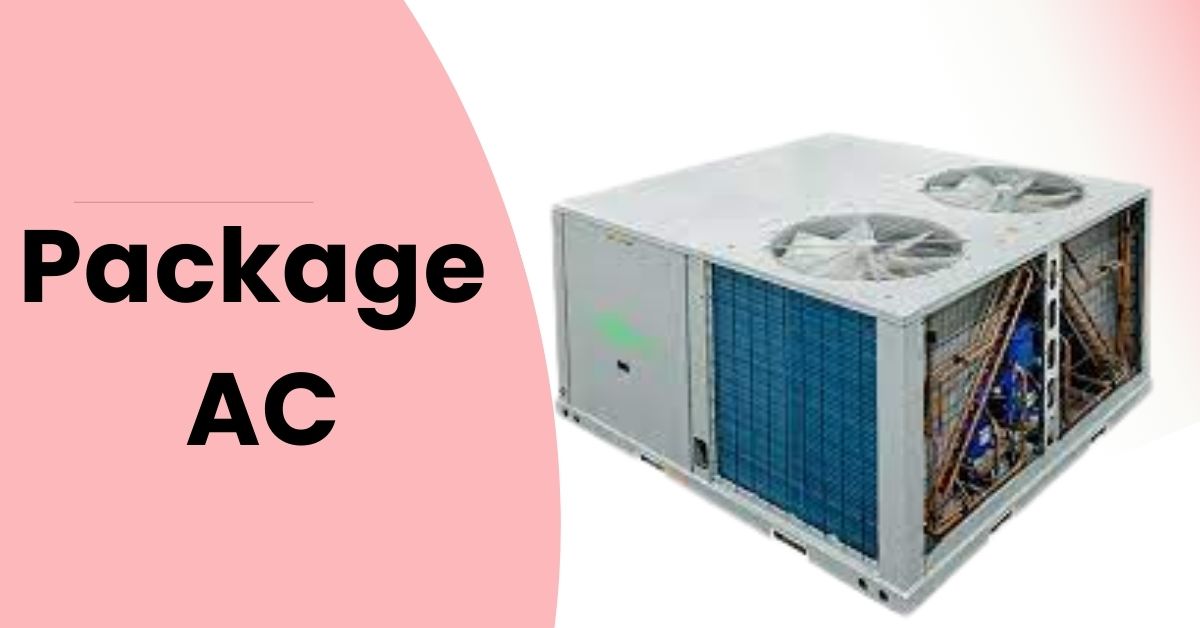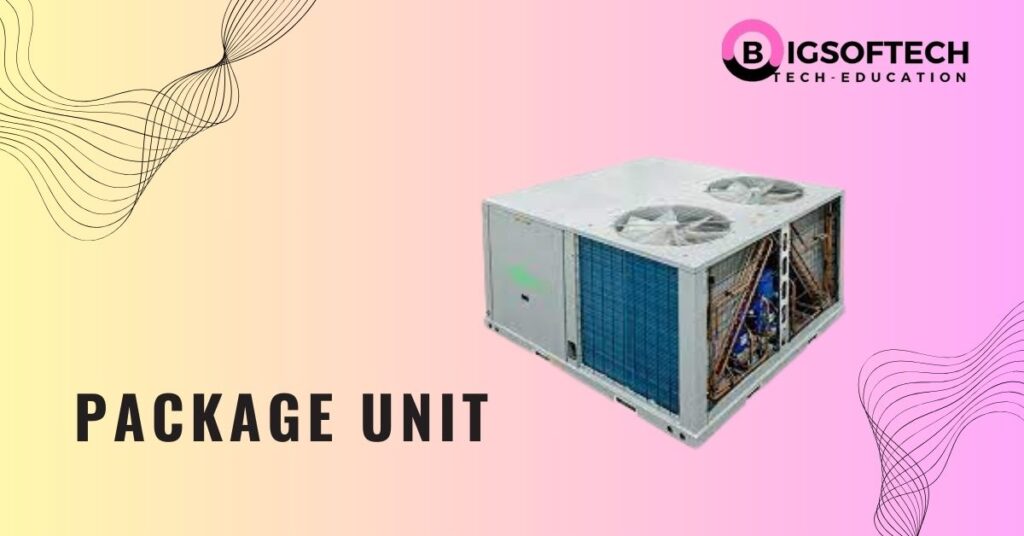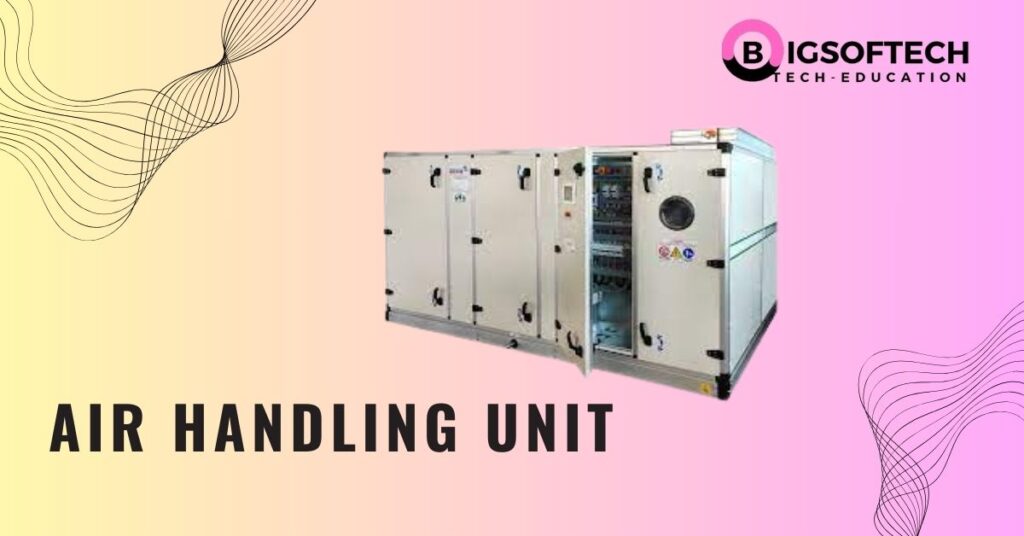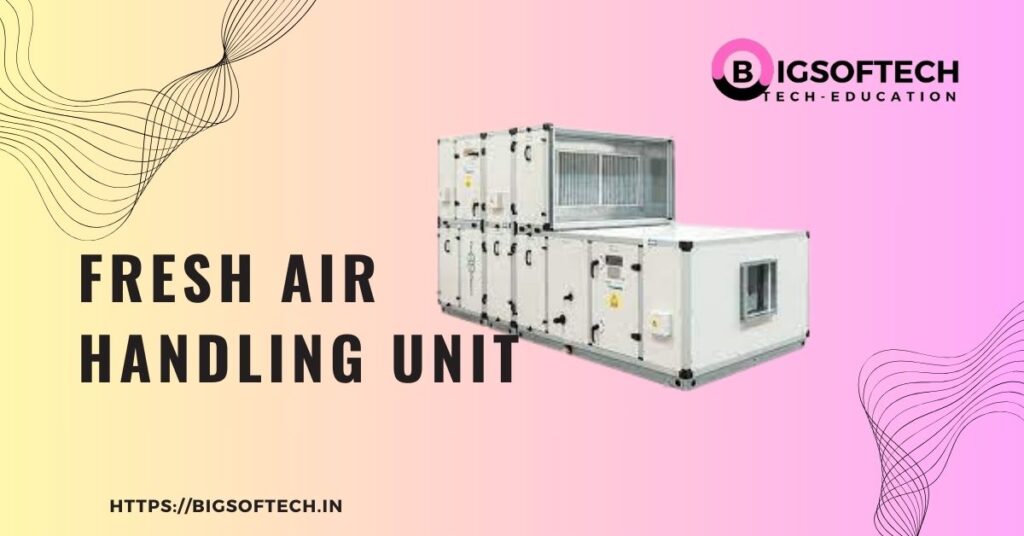What is a Package Air Conditioner? A package air conditioner is an all-in-one cooling system that keeps indoor spaces cool and comfortable, especially in hot weather. It has all its main parts, like the compressor, condenser, and evaporator, built into a single unit. This makes it easy to install and saves space. Package air conditioners are a popular choice for homes and businesses because they provide reliable cooling and are simple to maintain.
Package air conditioners are commonly used in both commercial and residential settings, providing efficient cooling and heating without taking up much indoor space.
This article aims to help you understand what is package air conditioner, how it works, and why it might be the right choice for your cooling and heating needs.
What is a Package Air Conditioner?


A package air conditioner is a self-contained HVAC (Heating, Ventilation, and Air Conditioning) system where all the components needed for cooling and heating are housed in a single unit. Unlike split air conditioners, which have separate indoor and outdoor units, a package air conditioner combines the compressor, condenser, and evaporator into one compact box.
These units are typically installed outdoors, such as on a roof or a concrete slab, and connect to the building’s ductwork to distribute conditioned air throughout the space.
Difference Between Split AC and Package AC
- Package Air Conditioner: All components are in one unit, making it easy to install and maintain. Ideal for spaces with limited indoor room for separate units.
- Split Air Conditioner: Has separate indoor and outdoor units, offering more flexibility in placement and quieter indoor operation.
Package air conditioners are a great choice for small commercial buildings, apartments, and homes where a centralized, space-saving cooling solution is needed.
Key Features of a Package Air Conditioner
Compact Design
A package air conditioner is designed to save space. Since all the components, including the compressor, condenser, and evaporator, are combined into a single unit, it eliminates the need for multiple installations. This makes it an excellent choice for areas with limited indoor space.
Multiple Components Housed in a Single Unit
Unlike split air conditioners, where components are divided between indoor and outdoor units, a package air conditioner houses everything in one enclosure. This design simplifies installation and maintenance, as technicians can access all parts in one place.
Types of Package Air Conditioners
Air-Cooled Package Units
Description and Working Principle
Air-cooled package air conditioners are compact systems where the condenser coil is cooled by air. These units are typically installed outdoors, such as on rooftops or building exteriors. The key components include:
- Compressor: Compresses refrigerant gas to high pressure and temperature.
- Condenser Coil: Releases heat from the refrigerant to the surrounding air.
- Evaporator Coil: Absorbs heat from the indoor air to cool it.
- Blower Fans: Circulate air over the evaporator coil for cooling and over the condenser coil for heat dissipation.
The working principle involves:
- The refrigerant is compressed in the compressor and sent to the condenser coil.
- In the condenser, the refrigerant releases heat to the outdoor air, aided by fans.
- The cooled refrigerant flows to the evaporator coil, where it absorbs heat from the indoor air.
- The cooled air is then distributed indoors through ductwork.
Advantages
- Easy installation as no additional water source is required.
- Lower maintenance compared to water-cooled systems.
- Suitable for dry climates where water availability is limited.
- Compact and self-contained design.
Limitations
- Less efficient in extremely hot climates due to reliance on ambient air for cooling.
- Noise levels can be higher due to outdoor installation and fan operation.
- Limited cooling capacity compared to water-cooled units.
Water-Cooled Package Units
Description and Working Principle
Water-cooled package air conditioners utilize water to cool the condenser coil instead of air. These units are typically installed indoors and require an external water source for operation. Key components include:
- Compressor: Compresses refrigerant gas to high pressure and temperature.
- Water-Cooled Condenser: Uses water to extract heat from the refrigerant.
- Evaporator Coil: Absorbs heat from the indoor air to cool it.
- Cooling Tower (optional): Circulates and cools the water for reuse.
The working principle involves:
- The refrigerant is compressed and sent to the water-cooled condenser.
- Heat from the refrigerant is transferred to the water, which is then cooled via a cooling tower or discharged.
- The cooled refrigerant moves to the evaporator coil, absorbing heat from the indoor air.
- The cooled air is distributed indoors through ducts.
Advantages
- Higher cooling efficiency, especially in hot climates.
- Quieter operation as the condenser is located indoors.
- Better performance in large-scale applications with significant cooling requirements.
- Can be paired with a cooling tower for water recirculation, reducing water waste.
Limitations
- Requires a reliable water source, making it unsuitable for areas with water scarcity.
- Higher initial setup and maintenance costs due to water supply and treatment systems.
- Occupies more indoor space due to the condenser and water handling equipment.
These package air conditioners are selected based on the application, climate, and availability of resources like water and space.
Components of a Package Air Conditioner
Compressor
- Role: The compressor is the heart of the system, responsible for compressing the refrigerant and circulating it through the system. It increases the refrigerant’s pressure and temperature, enabling heat transfer within the condenser and evaporator.
Condenser
- Function: The condenser removes heat from the refrigerant and releases it to the outside environment. It facilitates the cooling of the refrigerant, preparing it for the next cycle of heat absorption.
Evaporator
- Role: The evaporator absorbs heat from the indoor air. As warm air passes over the evaporator coil, the refrigerant within absorbs the heat, cooling the air before it is distributed indoors.
Fan and Blower
- Importance: Fans and blowers ensure proper airflow distribution. The blower circulates cooled air indoors, while fans assist in the heat dissipation process by moving air over the condenser coils.
Refrigerant
- Explanation: The refrigerant is a chemical compound that facilitates the cooling process by absorbing and releasing heat as it cycles through the system. It undergoes phase changes between liquid and gas to enable heat transfer.
Air Filters
- Role: Air filters maintain indoor air quality by trapping dust, allergens, and other particles from the air. They ensure clean airflow and protect the internal components of the air conditioner from debris.
How Does a Package Air Conditioner Work?
Working Principle of Package AC
Cooling Cycle
- Step-by-Step Explanation of the Refrigeration Cycle:
- Compression: The compressor compresses the refrigerant, increasing its pressure and temperature, converting it into a high-pressure gas.
- Condensation: The refrigerant flows to the condenser, where it releases heat to the outside environment and condenses into a high-pressure liquid.
- Expansion: The high-pressure liquid refrigerant passes through an expansion valve, where its pressure and temperature drop significantly.
- Evaporation: The low-pressure refrigerant enters the evaporator coil, where it absorbs heat from the indoor air, turning back into a gas.
- Recirculation: The cycle repeats as the refrigerant returns to the compressor.
- Role of Each Component:
- Compressor: Compresses and circulates refrigerant.
- Condenser: Releases absorbed heat to the outdoors.
- Evaporator: Absorbs heat from indoor air.
- Expansion Valve: Reduces refrigerant pressure and temperature.
Heating Cycle
- Explanation of Reverse Cycle for Heating:
- Some package air conditioners are equipped with heat pump functionality, allowing them to reverse the refrigeration cycle for heating.
- During heating, the refrigerant absorbs heat from the outside air and releases it indoors.
- The evaporator and condenser switch roles: the outdoor coil acts as the evaporator, and the indoor coil becomes the condenser.
Airflow Mechanism
- Details on Air Movement:
- Air Intake: Indoor air is drawn into the system through return ducts.
- Cooling or Heating: The air passes over the evaporator coil, where it is either cooled or heated, depending on the mode.
- Air Distribution: The blower fan circulates the treated air back into the indoor space through supply ducts.
- Filtration: Air filters remove dust and particles, ensuring clean airflow throughout the process.
Advantages of Package Air Conditioners
- Space-Saving Design:
Package air conditioners combine all components (compressor, condenser, evaporator, etc.) into a single unit, reducing the need for separate indoor and outdoor systems. This compact design saves valuable space, making them ideal for locations with limited room. - Easy Installation:
These systems are pre-assembled, reducing installation time and complexity. They require minimal ductwork and can be placed on rooftops, balconies, or ground-level spaces, simplifying setup. - Cost Efficiency for Certain Applications:
Package units are often more affordable for cooling medium to large spaces, such as commercial buildings, factories, and large homes. Their self-contained design minimizes the need for extensive infrastructure. - Energy Efficiency Options in Modern Units:
Advanced models come with energy-saving features like high Seasonal Energy Efficiency Ratios (SEER), variable-speed compressors, and smart control systems. These innovations help reduce energy consumption and operational costs.
Limitations of Package Air Conditioners
- Limited Capacity for Larger Spaces:
While suitable for medium-sized applications, package air conditioners may struggle to cool or heat very large spaces efficiently. For extensive areas, multiple units or alternative HVAC systems may be necessary. - Maintenance Challenges in Certain Models:
Due to their compact design, accessing internal components for repairs or maintenance can be more challenging compared to split systems. This may lead to higher service costs or longer downtime. - Noise Concerns in Some Units:
Some package units, especially air-cooled models, can generate significant noise during operation due to fan and compressor activity. This can be disruptive if the unit is installed near occupied spaces.
Applications of Package Air Conditioners
- Use in Small Offices, Retail Stores, and Residential Properties:
Package air conditioners are ideal for cooling and heating spaces such as small offices, retail outlets, restaurants, and residential homes. Their compact and efficient design makes them a cost-effective solution for these applications. - Suitability for Areas Where Space for Installation is Limited:
These systems are perfect for locations with space constraints, such as urban areas, rooftops, or compact buildings. Their all-in-one design eliminates the need for separate indoor and outdoor units, optimizing available space.
Maintenance Tips for Package Air Conditioners
- Regular Filter Cleaning and Replacement:
Clean the air filters periodically to prevent clogging and ensure efficient airflow. Replace filters as recommended by the manufacturer to maintain indoor air quality and system performance. - Ensuring Refrigerant Levels Are Adequate:
Check refrigerant levels regularly to ensure optimal cooling or heating efficiency. Low refrigerant levels can strain the compressor and reduce the system’s performance. - Checking for Leaks or Unusual Noises:
Inspect the unit for any refrigerant leaks, water drips, or unusual noises, such as rattling or hissing. Addressing these issues early can prevent major breakdowns and costly repairs. - Professional Servicing Schedule:
Schedule regular maintenance with a professional HVAC technician to inspect and service key components like the compressor, condenser coils, and electrical connections. This ensures the system runs efficiently and extends its lifespan. - Inspect the Condenser Coils:
Regularly clean and inspect the condenser coils for dirt, debris, or corrosion. Dirty coils can reduce the unit’s efficiency and cause the system to overheat. Use a soft brush or a coil cleaner for cleaning. - Check and Maintain Drainage System:
Ensure the drainage system is free from blockages. A clogged drain can lead to water leakage, damaging the unit and surrounding areas. Clear the condensate drain regularly to prevent water buildup. - Lubricate Moving Parts:
Lubricate the fan and blower motor bearings as per the manufacturer’s guidelines. Proper lubrication reduces friction and prevents wear, ensuring smooth operation and longer life of the components. - Ensure Proper Airflow Around the Unit:
Keep the area around the package unit clear of obstructions like furniture, plants, or debris. This allows the unit to expel hot air effectively and promotes better airflow for efficient cooling or heating. - Inspect Insulation:
Check the insulation on refrigerant lines and ductwork to prevent energy loss. Damaged or worn-out insulation should be replaced to maintain optimal system performance and reduce energy consumption. - Monitor Thermostat Settings:
Regularly check thermostat settings to ensure that they are functioning accurately. A malfunctioning thermostat can cause the unit to run inefficiently or fail to maintain the desired temperature. - Examine Electrical Components:
Inspect electrical connections and wiring for any signs of wear, damage, or loose connections. Faulty electrical components can lead to system malfunctions or pose safety hazards. - Test Unit Before Peak Seasons:
Before the start of the cooling or heating season, test the system to ensure it’s working efficiently. This allows time for any necessary repairs or adjustments before heavy usage.
Conclusion
Package air conditioners are efficient, all-in-one cooling and heating solutions that combine key components like the compressor, condenser, and evaporator into a single unit. They are ideal for applications where space is limited and offer convenience and cost-effectiveness for small to medium-sized spaces. These units work by circulating refrigerant through a cycle of compression, condensation, expansion, and evaporation, transferring heat between indoor and outdoor environments.
Choosing the right package air conditioner is crucial for ensuring optimal performance and energy efficiency. Factors such as space size, climate, and energy requirements should be considered when selecting a unit to meet specific needs.
For proper installation and ongoing maintenance, it’s essential to consult HVAC professionals. They can help ensure that the system is installed correctly, performs efficiently, and remains in good working condition through regular servicing, allowing you to enjoy reliable comfort for years to come.



